East Aquhorthies
Recumbent Stone Circle (Neolithic) - (Bronze Age)
Site Name East Aquhorthies
Classification Recumbent Stone Circle (Neolithic) - (Bronze Age)
Alternative Name(s) East Aquhorties; Easter Aquhorthies
Canmore ID 18981
Site Number NJ72SW 12
NGR NJ 7323 2079
Datum OSGB36 - NGR
Permalink http://canmore.org.uk/site/18981

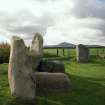






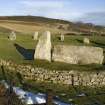
















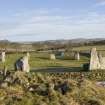











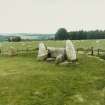







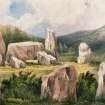





























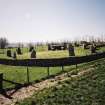



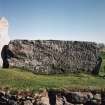









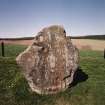






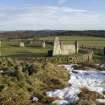




First 100 images shown. See the Collections panel (below) for a link to all digital images.
- Council Aberdeenshire
- Parish Inverurie
- Former Region Grampian
- Former District Gordon
- Former County Aberdeenshire
Easter Aquhorthies, 3rd millennium BC. Excellent example of a recumbent stone circle, showing clearly an interest in differing types of stone on the part of the early farmers. Now on The Stone Circle, Aberdeenshire Council's archaeological trail.
Taken from "Aberdeenshire: Donside and Strathbogie - An Illustrated Architectural Guide", by Ian Shepherd, 2006. Published by the Rutland Press http://www.rias.org.uk
NJ72SW 12 7323 2079.
(NJ 7232 2079) Stone Circle (NR)
OS 6" map, (1959)
An intact, recumbent stone circle consisting of eleven erect stones, the recumbent stone and three stones set almost at right angles to it, all set in a low ridge of small boulders.
The erect stones, unusually broad and massive, range in height from 3'10"(1.17m) to 5'10" (1.78m) and are of pinkish porphyry or red jasper except the 'pillars' which are of grey granite and stand 7' - 8' (2.13-2.43m) high. The recumbent stone is 12'6" 3.81m) long, of reddish granite. The diameter of the circle is 64' - 66' (19.5-20.1m). The interior, grassy here and there, uneven with small stones, has a slight but even rise towards the centre which may suggest that it is undisturbed. There are no stone settings in the interior. The circle is surrounded by a stone dyke and is clear of vegetation.
F R Coles 1901; H A W Burl 1973.
A recumbent stone circle, generally as described and planned, except that there is no evidence for the stones being set in 'a low ridge of small boulders'.
Revised at 1:2500.
Visited by OS (ISS) 16 July 1973.
This recumbent stone circle is situated near the crest of a long sloping shoulder and has commanded views to the S (now closed) and N; it is now surrounded by a stone dyke and is clear of vegetation.
The circle comprises eleven erect stones, the recumbent stone and three stones set at right-angles to the recumbent; the erect stones are unusually broad and massive and are of pinkish porphyry or red jasper escept for the 'pillars' which are of grey granite while the recumbent is of reddish granite.
A possible ring-cairn and a cist have been identified within the interior which is grassy and uneven with small stones; the slight but even rise towards the centre may suggest that there has been no disturbance.
Information from Aberdeenshire Archaeological Service, June 1997.
NMRS, MS/712/19.
Publication Account (1986)
An impressive recumbent stone circle, 19.5 m in diameter, consisting of nine erect stones, the recumbent, two flankers and, in addition, two massive blocks which form a reserved area in front of the recumbent (cf Loanhead, no. 98; Eslie, no. 92). The circle is located near the crest of a hill shoulder, at 175 m OD. The characteristic differentiation between the recumbent with its flankers and the other circle stones can be seen vividly, both in terms of height of stones and their geological origin. The stones are graded in height from the 2.25 m tall flankers to the 1.7 m high stones on the circumference opposite, and, while the nine circle stones are of rough pinkish porphyry or (in the case of the stone next to the east flanker) a glowing red jasper, the flankers are of grey granite and the recumbent of reddish granite from near Bennachie. The outer face of the 3.8 m long recumbent has been smoothed carefully. The circle stones are set in a low bank which has been partly augmented in recent times. The very slight rise in the interior and a 1934 reference to a cist suggest the existence of a later ring cairn, now vestigial. Its almost perfectly circular plan places this circle early in the series of recumbent stone circles.
Information from ‘Exploring Scotland’s Heritage: Grampian’, (1986).
Publication Account (1996)
An impressive recumbent stone circle, 19.5m in diameter, consisting of nine erect stones, the recumbent, two flankers and, in addition, two massive blocks which form a reserved area in front of the recumbent (cf Loanhead, no. 98; Eslie, (no. 92). The circle is located near the crest of a hill shoulder, at 175m OD. The characteristic differentiation between the recumbent with its flankers and the other circle stones can be seen vividly, both in terms of height of stones and their geological origin. The stones are graded in height from the 2.25m tall flankers to the 1.7m high stones on the circumference opposite, and, while the nine circle stones are of rough pinkish porphyry or (in the case of the second stone to the east of the east flanker) a glowing red jasper, the flankers are of grey granite and the recumbent of reddish granite from near Bennachie. The outer face of the 3.8m long recumbent has been smoothed carefully. The circle stones are set in a low bank which has been partly augmented in recent times. The very slight rise in the interior and a 1934 reference to a cist suggest the existence of a later ring cairn, now extremely vestigial. Its almost perfectly circular plan places this circle early in the series of recumbent stone circles.
Information from ‘Exploring Scotland’s Heritage: Aberdeen and North-East Scotland’, (1996).
Field Visit (24 August 1998 - 26 August 1998)
This recumbent stone circle, which is tightly enfolded within a small fenced and walled enclosure, stands on a gentle E-facing slope about 300m NW of East Aquhorthies; held in Guardianship, the enclosure is mowed and regularly maintained, with easy access from a car park nearby. The circle measures 20m from ESE to WNW by 18.5m transversely overall and is one of the few with its full complement of stones, comprising the recumbent setting on the SSW and nine orthostats. The recumbent (2) measures about 4m in length by 1.55m in height, and its spectacular leading face is shot with white bars of quartz (slickensides); an OS benchmark cut just below its relatively even summit roughly midway along this face was considered by Alexander Keiller an act of vandalism that had probably encouraged the graffiti carved into the inner faces of two of the orthostats (9 & 10). Behind the recumbent two large slabs are set on edge at roughly right-angles to it and flush with its ends. The two flankers, standing 2.5m and 2.15m high respectively, are the tallest stones in the ring, both of them aligned with the front of the recumbent and turned slightly to trace the arc of the circle. The western (1), which is not only slightly taller than its eastern neighbour (3) but also more slender, displays three cupmarks near the foot of its outer face, with a possible fourth a little further to the W. The nine evenly-spaced orthostats are graded in height, their tops descending consistently from the flankers on the SSW to a slab little more than 1m high on the NE (7). The visual impression presented by the interior of the circle is heavily influenced by the later enclosure, which has a thick bank behind its external stone face. At least five of the orthostats stand in the tail of this bank, which creates the allusion that the interior is dished. This is far from the case, as can be seen from the section. This clearly shows that there is a low mound about 0.25m high within the interior; it is almost certainly the remains of an internal cairn.
Visited by RCAHMS (ATW and KHJM) 24-6 August 1998










































































































